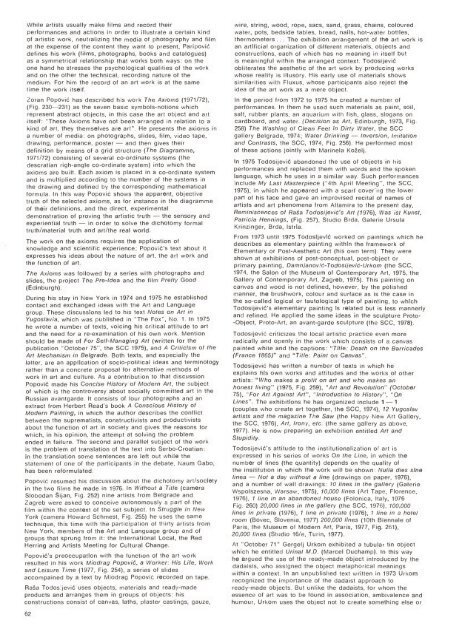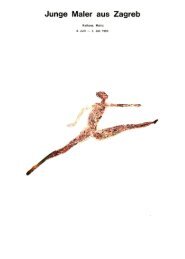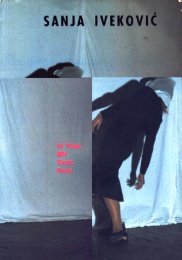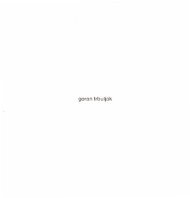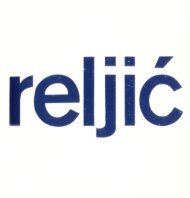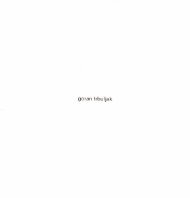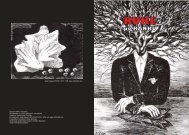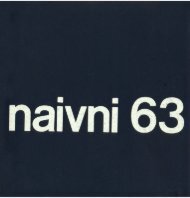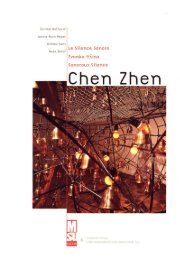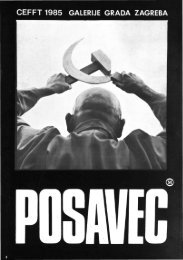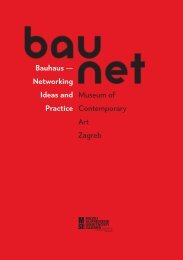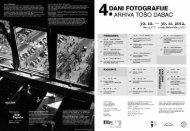The New Art Practice in Yugoslavia, 1966-1978
The New Art Practice in Yugoslavia, 1966-1978
The New Art Practice in Yugoslavia, 1966-1978
- TAGS
- practice
- yugoslavia
- www.msu.hr
Create successful ePaper yourself
Turn your PDF publications into a flip-book with our unique Google optimized e-Paper software.
While artists usually make films and record their<br />
performances and actions <strong>in</strong> order to illustrate a certa<strong>in</strong> k<strong>in</strong>d<br />
of artistic work, neutraliz<strong>in</strong>g the media of photography and film<br />
at the expense of the content they want to present, Paripovi<br />
def<strong>in</strong>es his work (films, photographs, books and catalogues)<br />
as a symmetrical relationship that works both ways: on the<br />
one hand he stresses the psychological qualities of the work<br />
and on the other the technical, record<strong>in</strong>g nature of the<br />
medium. For him the record of an art work is at the same<br />
time the work itself.<br />
Zoran Popovi has described his work <strong>The</strong> Axioms (1971/72),<br />
(Fig. 230-231) as the seven basic symbols-notions which<br />
represent abstract objects, <strong>in</strong> this case the art object and art<br />
itself: "<strong>The</strong>se Axioms have not been arranged <strong>in</strong> relation to a<br />
k<strong>in</strong>d of art, they themselves are art". He presents the axioms <strong>in</strong><br />
a number of media: on photographs, slides, film, video tape,<br />
draw<strong>in</strong>g. performance, poster and then gives their<br />
def<strong>in</strong>ition by means of a grid structure (<strong>The</strong> Diagramme,<br />
1971/72) consist<strong>in</strong>g of several co-ord<strong>in</strong>ate systems (the<br />
descratian righ-angle co-ord<strong>in</strong>ate system) <strong>in</strong>to which the<br />
axioms are built. Each axiom is placed <strong>in</strong> a co-ord<strong>in</strong>ate system<br />
and is multiplied accord<strong>in</strong>g to the number of the systems <strong>in</strong><br />
the draw<strong>in</strong>g and def<strong>in</strong>ed by the correspond<strong>in</strong>g mathematical<br />
formula. In this way Popovi shows the apparent, objective<br />
truth of the selected axioms, as for <strong>in</strong>stance <strong>in</strong> the diagramme<br />
of their def<strong>in</strong>itions, and the direct, experimental<br />
demonstration of prov<strong>in</strong>g the artistic truth the sensory and<br />
experiential truth <strong>in</strong> order to solve the dichotomy formal<br />
truth/material truth and art/the real world.<br />
<strong>The</strong> work on the axioms requires the application of<br />
knowledge and scientific experience; Popovi's text about it<br />
expresses his ideas about the nature of art, the art work and<br />
the function of art.<br />
<strong>The</strong> Axioms was followed by a series with photographs and<br />
slides, the project <strong>The</strong> Pre-Idea and the film Pretty Good<br />
(Ed<strong>in</strong>burgh).<br />
Dur<strong>in</strong>g his stay <strong>in</strong> <strong>New</strong> York <strong>in</strong> 1974 and 1975 he established<br />
contact and exchanged ideas with the <strong>Art</strong> and Language<br />
group. <strong>The</strong>se discussions led to his text Notes on <strong>Art</strong> <strong>in</strong><br />
<strong>Yugoslavia</strong>, which was published <strong>in</strong> "<strong>The</strong> Fox", No. 1. In 1975<br />
he wrote a number of texts, voic<strong>in</strong>g his critical attitude to art<br />
and the need for a re-exam<strong>in</strong>ation of his own work. Mention<br />
should be made of For Self-Manag<strong>in</strong>g <strong>Art</strong> (written for the<br />
publication "October 75", the SCC 1975), and A Criticism of the<br />
<strong>Art</strong> Mechanism <strong>in</strong> Belgrade. Both texts, and especially the<br />
latter, are an application of socio-political ideas and term<strong>in</strong>ology<br />
rather than a concrete proposal for alternative methods of<br />
work <strong>in</strong> art and culture. As a contribution to that discussion<br />
Popovi made his Concise History of Modern <strong>Art</strong>, the subject<br />
of which is the controversy about socially committed art <strong>in</strong> the<br />
Russian avantgarde. It consists of four photographs and an<br />
extract from Herbert Read's book A Conscious History of<br />
Modern Pa<strong>in</strong>t<strong>in</strong>g, <strong>in</strong> which the author describes the conflict<br />
between the suprematists, constructivists and productivists<br />
about the function of art <strong>in</strong> society and gives the reasons for<br />
which, <strong>in</strong> his op<strong>in</strong>ion, the attempt at solv<strong>in</strong>g the problem<br />
ended <strong>in</strong> failure. <strong>The</strong> second and parallel subject of the work<br />
is the problem of translation of the text <strong>in</strong>to Serbo-Croatian:<br />
<strong>in</strong> the translation some sentences are left out while the<br />
statement of one of the participants <strong>in</strong> the debate. Naum Gabo,<br />
has been reformulated.<br />
Popovi resumed his discussion about the dichotomy art/society<br />
<strong>in</strong> the two films he made <strong>in</strong> 1976. In Without a Title (camera<br />
Slobodan ijan, Fig. 252) n<strong>in</strong>e artists from Belgrade and<br />
Zagreb were asked to conceive autonomously a part of the<br />
film with<strong>in</strong> the context of the set subject. In Struggle <strong>in</strong> <strong>New</strong><br />
York (camera Howard Schmest, Fig. 255) he uses the same<br />
technique, this time with the participation of thirty artists from<br />
<strong>New</strong> York, members of the <strong>Art</strong> and Language group and of<br />
groups that sprung from it: the International Local, the Red<br />
Herr<strong>in</strong>g and <strong>Art</strong>ists Meet<strong>in</strong>g for Cultural Change.<br />
Popovi's preoccupation with the function of the art work<br />
resulted <strong>in</strong> his work Miodrag Popovi, a Worker: His Life. Work<br />
and Leisure Time (1977, Fig. 254), a series of slides<br />
accompa<strong>in</strong>ed by a text by Miodrag Popovi recorded on tape.<br />
Rasa Todosjevi uses objects, materials and ready-made<br />
products and arranges them <strong>in</strong> groups of objects: his<br />
constructions consist of canvas, laths, plaster cast<strong>in</strong>gs, gauze,<br />
62<br />
wire, str<strong>in</strong>g, wood, rope, sacs, sand, grass, cha<strong>in</strong>s, coloured<br />
water, pots, bedside tables, bread, nails, hot-water bottles,<br />
thermometers ... <strong>The</strong> exhibition arrangement of the art work is<br />
an artificial organization of different materials, objects and<br />
constructions, each of which has no mean<strong>in</strong>g <strong>in</strong> itself but<br />
is mean<strong>in</strong>gful with<strong>in</strong> the arranged context. Todosijevi<br />
obliterates the aesthetic of the art work by produc<strong>in</strong>g works<br />
whose reality is illusory. His early use of materials shows<br />
similarities with Fluxus, whose participants also reject the<br />
idea of the art work as a mere object.<br />
In the period from 1972 to 1975 he created a number of<br />
performances. In them he used such materials as pa<strong>in</strong>t, soil,<br />
salt, rubber plants, an aquarium with fish, glass, slogans on<br />
cardboard, and water. (Decision as <strong>Art</strong>. Ed<strong>in</strong>burgh. 1973. Fig.<br />
258) <strong>The</strong> Wash<strong>in</strong>g of Clean Feet <strong>in</strong> Dirty Water, the SCC<br />
gallery Belgrade. 1974: Water Dr<strong>in</strong>k<strong>in</strong>g Inversion, Imitation<br />
and Contrasts, the SCC, 1974. Fig. 256). He performed most<br />
of these actions jo<strong>in</strong>tly with Mar<strong>in</strong>ela Koelj.<br />
In 1975 Todosijevi abandoned the use of objects <strong>in</strong> his<br />
performances and replaced them with words and the spoken<br />
language, which he uses <strong>in</strong> a similar way. Such performances<br />
<strong>in</strong>clude My Last Masterpiece ("4th April Meet<strong>in</strong>g", the SCC,<br />
1975), <strong>in</strong> which he appeared with a scarf cover'ng the lower<br />
part of his face and gave an improvised recital of names of<br />
artists and art phenomena from Altamira to the present day,<br />
Rem<strong>in</strong>iscences of Raga Todosijevi's <strong>Art</strong> (1976), Was ist Kunst,<br />
Patricia Henn<strong>in</strong>gs, (Fig. 257), Studio Brda, Galerie Ursula<br />
Kr<strong>in</strong>z<strong>in</strong>ger, Brda, Istria.<br />
From 1973 until 1975 Todosijevi worked on pa<strong>in</strong>t<strong>in</strong>gs which he<br />
describes as elementary pa<strong>in</strong>t<strong>in</strong>g with<strong>in</strong> the framework of<br />
Elementary or Post-Aesthetic <strong>Art</strong> (his own term). <strong>The</strong>y were<br />
shown at exhibitions of post-conceptual, post-object or<br />
primary pa<strong>in</strong>t<strong>in</strong>g, Damnjanovj-Todosijevi-Urkom (the SCC,<br />
1974, the Salon of the Museum of Contemporary <strong>Art</strong>, 1975, the<br />
Gallery of Contemporary <strong>Art</strong>, Zagreb, 1975). This pa<strong>in</strong>t<strong>in</strong>g on<br />
canvas and wood is not def<strong>in</strong>ed, however, by the polished<br />
manner, the brushwork, colour and surface as is the case <strong>in</strong><br />
the so-called logical or tautological type of pa<strong>in</strong>t<strong>in</strong>g, to which<br />
Todosijevi's elementary pa<strong>in</strong>t<strong>in</strong>g is related but is less mannerly<br />
and ref<strong>in</strong>ed. He applied the same ideas <strong>in</strong> the sculpture Proto-<br />
-Object, Proto-<strong>Art</strong>, an avant-garde sculpture (the SCC. <strong>1978</strong>).<br />
Todosijevi criticizes the local artistic practice even more<br />
radically and openly <strong>in</strong> the work which consists of a canvas<br />
pa<strong>in</strong>ted white and the captions: "Title: Death on the Barricades<br />
(France 1865)" and "Title: Pa<strong>in</strong>t on Canvas".<br />
Todosijevi has written a number of texts <strong>in</strong> which he<br />
expla<strong>in</strong>s his own works and attitudes and the works of other<br />
artists: "Who makes a profit on art and who makes an<br />
honest liv<strong>in</strong>g" (1975. Fig. 259), "<strong>Art</strong> and Revolution" (October<br />
75), "For <strong>Art</strong> Aga<strong>in</strong>st <strong>Art</strong>", "Introduction to History". "On<br />
L<strong>in</strong>es". <strong>The</strong> exhibitions he has organized <strong>in</strong>clude 1 1<br />
(couples who create art together, the SCC, 1974), 12 Yugoslav<br />
artists and the magaz<strong>in</strong>e <strong>The</strong> Saw (the Happy <strong>New</strong> <strong>Art</strong> Gallery,<br />
the SCC, 1976), <strong>Art</strong>, Irony, etc. (the same gallery as above,<br />
1977). He is now prepar<strong>in</strong>g an exhibition entitled <strong>Art</strong> and<br />
Stupidity.<br />
Todosijevi's attitude to the <strong>in</strong>stitutionalization of art is<br />
expressed <strong>in</strong> his series of works On the L<strong>in</strong>e, <strong>in</strong> which the<br />
number of l<strong>in</strong>es (the quantity) depends on the quality of<br />
the <strong>in</strong>sititution <strong>in</strong> which the work will be shown: Nulla dies s<strong>in</strong>e<br />
l<strong>in</strong>ea Not a day without a l<strong>in</strong>e (draw<strong>in</strong>gs on paper, 1976),<br />
and a number of wall draw<strong>in</strong>gs: 10 l<strong>in</strong>es <strong>in</strong> the gallery (Galerie<br />
Wspolszesna, Warsaw, 1975), 10,000 l<strong>in</strong>es (<strong>Art</strong> Tape, Florence,<br />
1976), 1 l<strong>in</strong>e <strong>in</strong> an abandoned house (Folonica, Italy, 1976<br />
Fig. 260) 20,000 l<strong>in</strong>es <strong>in</strong> the gallery (the SCC, 1976), 100,000<br />
l<strong>in</strong>es <strong>in</strong> private (1976), 1 l<strong>in</strong>e <strong>in</strong> private (1976), 1 l<strong>in</strong>e <strong>in</strong> a hotel<br />
room (Bovec, Slovenia, 1977) 200,000 l<strong>in</strong>es (10th Biennale of<br />
Paris, the Museum of Modern <strong>Art</strong>, Paris, 1977, Fig. 261),<br />
20,000 l<strong>in</strong>es (Studio 16/e, Tur<strong>in</strong>, 1977).<br />
At "October 71" Gergelj Urkom exhibited a tubular t<strong>in</strong> object<br />
which he entitled Ur<strong>in</strong>al M.D. (Marcel Duchamp). In this way<br />
he argued the use of the ready-made object <strong>in</strong>troduced by the<br />
dadaists, who ass:gned the object metaphorical mean<strong>in</strong>gs<br />
with<strong>in</strong> a context. In an unpublished text written <strong>in</strong> 1973 Urkom<br />
recognized the importance of the dadaist approach to<br />
ready-made objects. But unlike the dadaists, for whom the<br />
essence of art was to be found <strong>in</strong> association, ambivalence and<br />
humour, Urkom uses the object not to create someth<strong>in</strong>g else or


